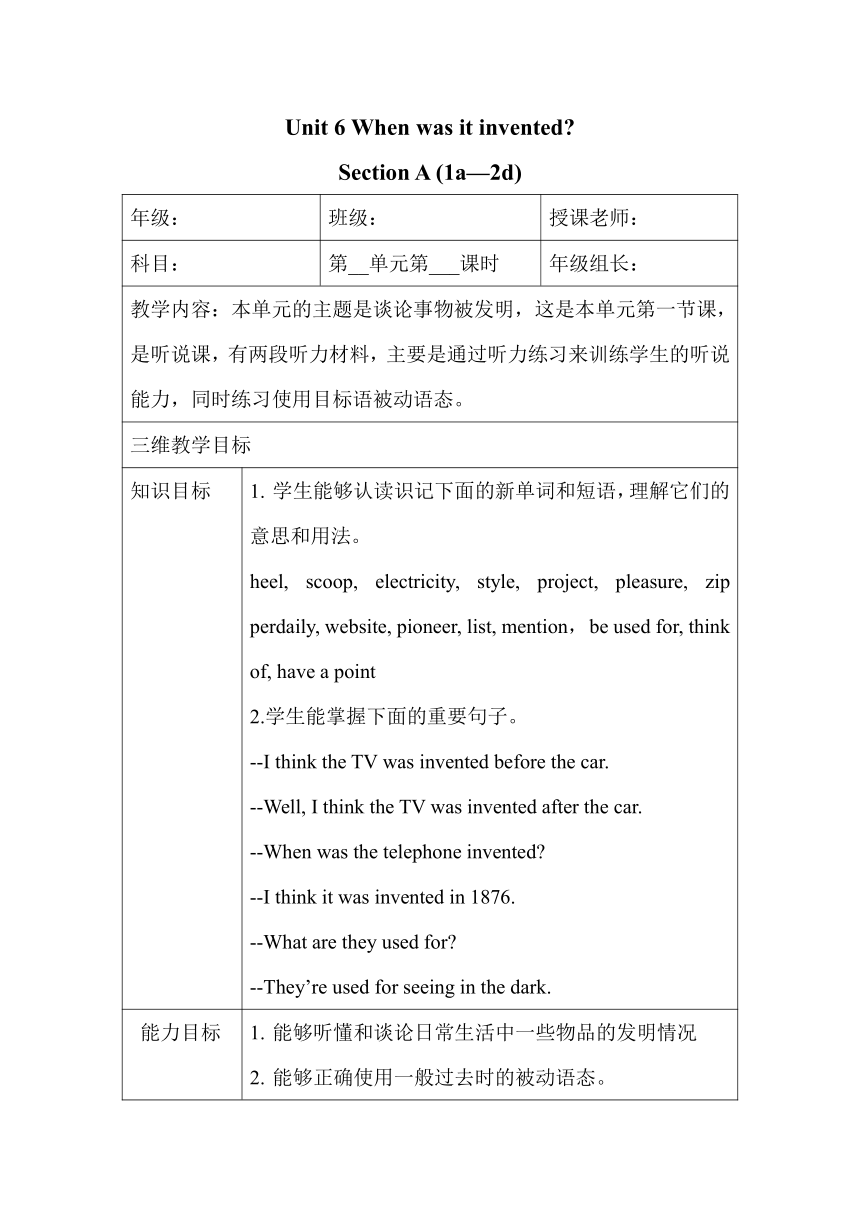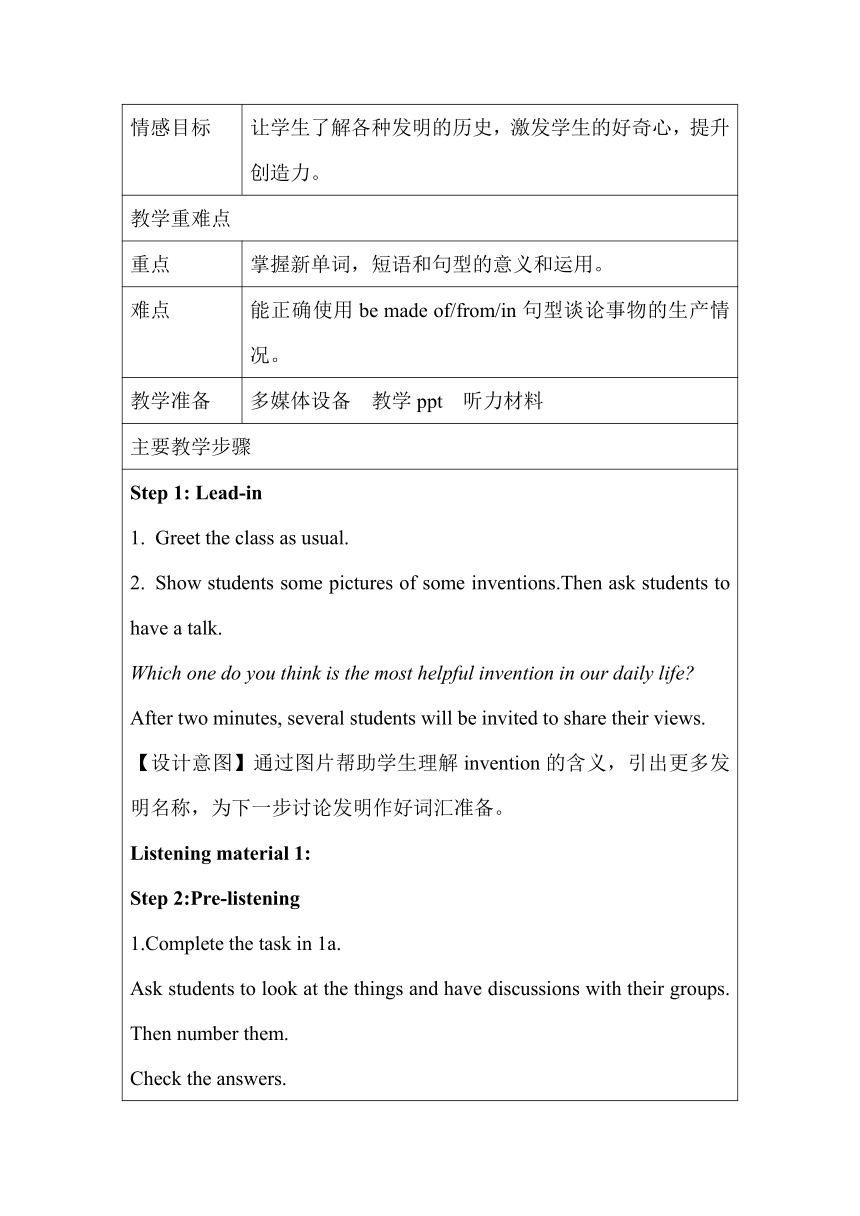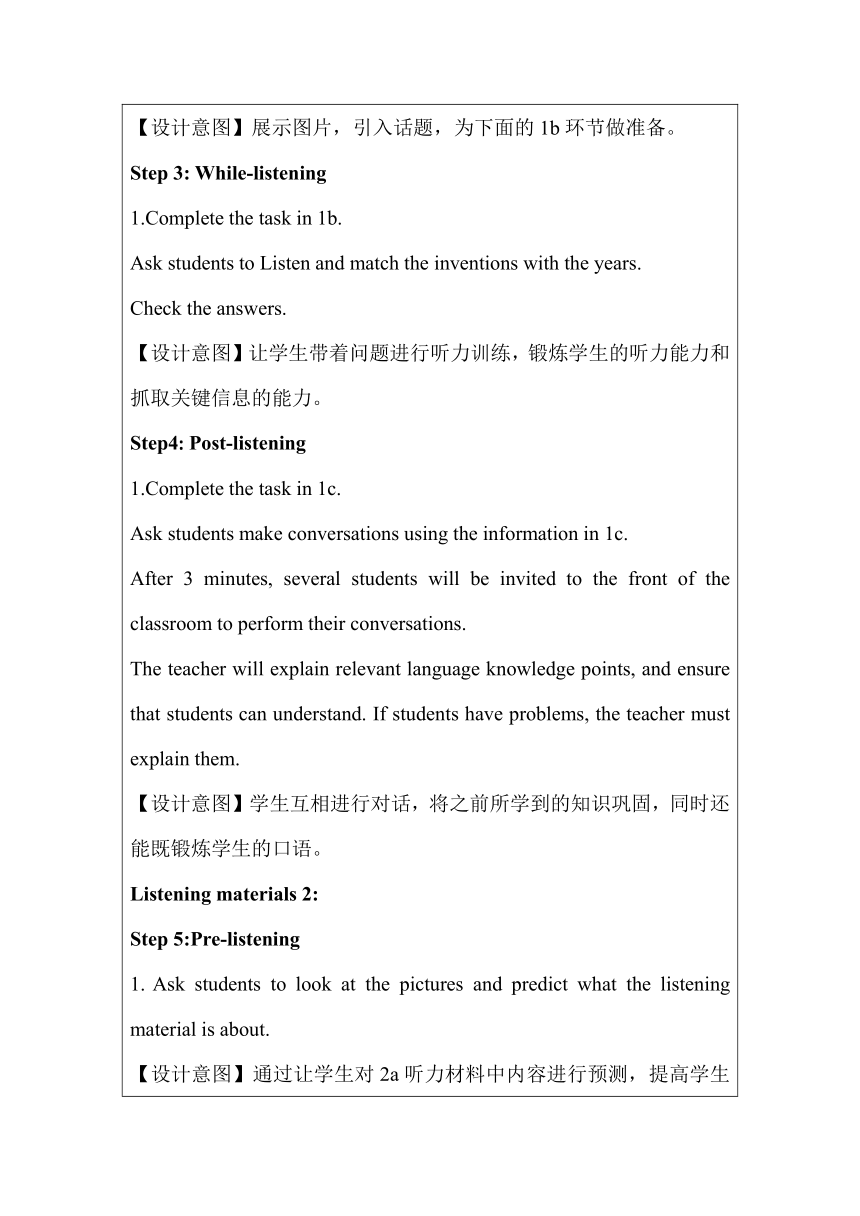Unit 6 When was it invented? Section A 1a-2d教案(表格式)
文档属性
| 名称 | Unit 6 When was it invented? Section A 1a-2d教案(表格式) |  | |
| 格式 | zip | ||
| 文件大小 | 20.9KB | ||
| 资源类型 | 教案 | ||
| 版本资源 | 人教新目标(Go for it)版 | ||
| 科目 | 英语 | ||
| 更新时间 | 2022-10-23 16:29:32 | ||
图片预览



文档简介
Unit 6 When was it invented
Section A (1a—2d)
年级: 班级: 授课老师:
科目: 第__单元第___课时 年级组长:
教学内容:本单元的主题是谈论事物被发明,这是本单元第一节课,是听说课,有两段听力材料,主要是通过听力练习来训练学生的听说能力,同时练习使用目标语被动语态。
三维教学目标
知识目标 学生能够认读识记下面的新单词和短语,理解它们的意思和用法。 heel, scoop, electricity, style, project, pleasure, zip perdaily, website, pioneer, list, mention, be used for, think of, have a point 2.学生能掌握下面的重要句子。 --I think the TV was invented before the car. --Well, I think the TV was invented after the car. --When was the telephone invented --I think it was invented in 1876. --What are they used for --They’re used for seeing in the dark.
能力目标 能够听懂和谈论日常生活中一些物品的发明情况 能够正确使用一般过去时的被动语态。
情感目标 让学生了解各种发明的历史,激发学生的好奇心,提升创造力。
教学重难点
重点 掌握新单词,短语和句型的意义和运用。
难点 能正确使用be made of/from/in句型谈论事物的生产情况。
教学准备 多媒体设备 教学ppt 听力材料
主要教学步骤
Step 1: Lead-in Greet the class as usual. Show students some pictures of some inventions.Then ask students to have a talk. Which one do you think is the most helpful invention in our daily life After two minutes, several students will be invited to share their views. 【设计意图】通过图片帮助学生理解invention的含义,引出更多发明名称,为下一步讨论发明作好词汇准备。 Listening material 1: Step 2:Pre-listening 1.Complete the task in 1a. Ask students to look at the things and have discussions with their groups. Then number them. Check the answers. 【设计意图】展示图片,引入话题,为下面的1b环节做准备。 Step 3: While-listening 1.Complete the task in 1b. Ask students to Listen and match the inventions with the years. Check the answers. 【设计意图】让学生带着问题进行听力训练,锻炼学生的听力能力和抓取关键信息的能力。 Step4: Post-listening 1.Complete the task in 1c. Ask students make conversations using the information in 1c. After 3 minutes, several students will be invited to the front of the classroom to perform their conversations. The teacher will explain relevant language knowledge points, and ensure that students can understand. If students have problems, the teacher must explain them. 【设计意图】学生互相进行对话,将之前所学到的知识巩固,同时还能既锻炼学生的口语。 Listening materials 2: Step 5:Pre-listening Ask students to look at the pictures and predict what the listening material is about. 【设计意图】通过让学生对2a听力材料中内容进行预测,提高学生预测能力。 Step 6: While-listening 1.Listen to the recording for the first time, then check your prediction. 2.Complete the task in 2a. Listen and number the inventions.Listen again and complete the chart. Check the answers . 3.Complete the task in 2b. Play the tape again. After listening, ask Ss to fill in the blanks. After 5 minutes, check the answers. 【设计意图】本环目的在训练学生的听力技能,体会被动语态在实际情景中的应用。 Step7: Post-listening 1.Complete the task in 2c. Make conversations using the information in 2a and 2b. After two minutes, several students will be invited to act out their conversations. 【设计意图】让学生自己进行表演对话,提高运用目标语言的能力和口头表达的能力。 2.Work on 2d (1). Listen and read. Then finish the task. (2). Role-play the conversation. 【设计意图】通过设置问题,让学生获取细节信息,锻炼学生快速获取信息的能力,同时让学生进行表演和对话,帮助学生在情境中加深对话题语言的运用。 Step8: Language points The teacher will explain relevant language knowledge points, and ensure that students can understand. If students have problems, the teacher must explain them. Step6: Exercises 一、选择题。 1. Paper ____first _____ about two thousand years ago in China by Cai Lun. A.is; inventing B. is; invented C. has; invented D. was; invented 2. English is widely used _______ many people around the world _______ a second language. A. by; for B. by; as C. as; for D. for; as 3. —Thank you for taking me around your school, Daming.
—________
A. Don’t mention it. B. Never mind. C. Of course not. D. No problem. 二、翻译下列句子。 1. 薯片是一个名叫乔治·克拉姆的厨师发明的。 2. 而且他在它们上面放了很多盐。 3.高铁被看作中国的新四大发明之一。
板书设计: Unit 6 When was it invented Section A (1a—2d) 1. Key words and phrases: style, project, pleasure, daily, website, pioneer, list, mention, be used for, with pleasure, think about 2.Important sentences: --I think the TV was invented before the car. --Well, I think the TV was invented after the car. --When was the telephone invented --I think it was invented in 1876. --What are they used for --They’re used for seeing in the dark.
小结: What have we learned in this class? Main language points: (1) invent用法 (2)be used for用法 (3)pleasure相关短语和用法(4)mention用法 (5)谓语动词的强调。
家庭作业: Copy and review the new words, phrases, important sentences and main language points . Preview the content of next class.
Section A (1a—2d)
年级: 班级: 授课老师:
科目: 第__单元第___课时 年级组长:
教学内容:本单元的主题是谈论事物被发明,这是本单元第一节课,是听说课,有两段听力材料,主要是通过听力练习来训练学生的听说能力,同时练习使用目标语被动语态。
三维教学目标
知识目标 学生能够认读识记下面的新单词和短语,理解它们的意思和用法。 heel, scoop, electricity, style, project, pleasure, zip perdaily, website, pioneer, list, mention, be used for, think of, have a point 2.学生能掌握下面的重要句子。 --I think the TV was invented before the car. --Well, I think the TV was invented after the car. --When was the telephone invented --I think it was invented in 1876. --What are they used for --They’re used for seeing in the dark.
能力目标 能够听懂和谈论日常生活中一些物品的发明情况 能够正确使用一般过去时的被动语态。
情感目标 让学生了解各种发明的历史,激发学生的好奇心,提升创造力。
教学重难点
重点 掌握新单词,短语和句型的意义和运用。
难点 能正确使用be made of/from/in句型谈论事物的生产情况。
教学准备 多媒体设备 教学ppt 听力材料
主要教学步骤
Step 1: Lead-in Greet the class as usual. Show students some pictures of some inventions.Then ask students to have a talk. Which one do you think is the most helpful invention in our daily life After two minutes, several students will be invited to share their views. 【设计意图】通过图片帮助学生理解invention的含义,引出更多发明名称,为下一步讨论发明作好词汇准备。 Listening material 1: Step 2:Pre-listening 1.Complete the task in 1a. Ask students to look at the things and have discussions with their groups. Then number them. Check the answers. 【设计意图】展示图片,引入话题,为下面的1b环节做准备。 Step 3: While-listening 1.Complete the task in 1b. Ask students to Listen and match the inventions with the years. Check the answers. 【设计意图】让学生带着问题进行听力训练,锻炼学生的听力能力和抓取关键信息的能力。 Step4: Post-listening 1.Complete the task in 1c. Ask students make conversations using the information in 1c. After 3 minutes, several students will be invited to the front of the classroom to perform their conversations. The teacher will explain relevant language knowledge points, and ensure that students can understand. If students have problems, the teacher must explain them. 【设计意图】学生互相进行对话,将之前所学到的知识巩固,同时还能既锻炼学生的口语。 Listening materials 2: Step 5:Pre-listening Ask students to look at the pictures and predict what the listening material is about. 【设计意图】通过让学生对2a听力材料中内容进行预测,提高学生预测能力。 Step 6: While-listening 1.Listen to the recording for the first time, then check your prediction. 2.Complete the task in 2a. Listen and number the inventions.Listen again and complete the chart. Check the answers . 3.Complete the task in 2b. Play the tape again. After listening, ask Ss to fill in the blanks. After 5 minutes, check the answers. 【设计意图】本环目的在训练学生的听力技能,体会被动语态在实际情景中的应用。 Step7: Post-listening 1.Complete the task in 2c. Make conversations using the information in 2a and 2b. After two minutes, several students will be invited to act out their conversations. 【设计意图】让学生自己进行表演对话,提高运用目标语言的能力和口头表达的能力。 2.Work on 2d (1). Listen and read. Then finish the task. (2). Role-play the conversation. 【设计意图】通过设置问题,让学生获取细节信息,锻炼学生快速获取信息的能力,同时让学生进行表演和对话,帮助学生在情境中加深对话题语言的运用。 Step8: Language points The teacher will explain relevant language knowledge points, and ensure that students can understand. If students have problems, the teacher must explain them. Step6: Exercises 一、选择题。 1. Paper ____first _____ about two thousand years ago in China by Cai Lun. A.is; inventing B. is; invented C. has; invented D. was; invented 2. English is widely used _______ many people around the world _______ a second language. A. by; for B. by; as C. as; for D. for; as 3. —Thank you for taking me around your school, Daming.
—________
A. Don’t mention it. B. Never mind. C. Of course not. D. No problem. 二、翻译下列句子。 1. 薯片是一个名叫乔治·克拉姆的厨师发明的。 2. 而且他在它们上面放了很多盐。 3.高铁被看作中国的新四大发明之一。
板书设计: Unit 6 When was it invented Section A (1a—2d) 1. Key words and phrases: style, project, pleasure, daily, website, pioneer, list, mention, be used for, with pleasure, think about 2.Important sentences: --I think the TV was invented before the car. --Well, I think the TV was invented after the car. --When was the telephone invented --I think it was invented in 1876. --What are they used for --They’re used for seeing in the dark.
小结: What have we learned in this class? Main language points: (1) invent用法 (2)be used for用法 (3)pleasure相关短语和用法(4)mention用法 (5)谓语动词的强调。
家庭作业: Copy and review the new words, phrases, important sentences and main language points . Preview the content of next class.
同课章节目录
- Unit 1 How can we become good learners.
- Section A
- Section B
- Unit 2 I think that mooncakes are delicious!
- Section A
- Section B
- Unit 3 Could you please tell me where the restroom
- Section A
- Section B
- Unit 4 I used to be afraid of the dark.
- Section A
- Section B
- Unit 5 What are the shirts made of?
- Section A
- Section B
- Review of Units 1-5
- Unit 6 When was it invented?
- Section A
- Section B
- Unit 7 Teenagers should be allowed to choose their
- Section A
- Section B
- Unit 8 It must belong to Carla.
- Section A
- Section B
- Unit 9 I like music that I can dance to.
- Section A
- Section B
- Unit 10 You're supposed to shake hands.
- Section A
- Section B
- Review of Units 6-10
- Unit 11 Sad movies make me cry.
- Section A
- Section B
- Unit 12 Life is full of the unexpected
- Section A
- Section B
- Unit 13 We're trying to save the earth!
- Section A
- Section B
- Unit 14 I remember meeting all of you in Grade 7.
- Section A
- Section B
- Review of Units 11-14
